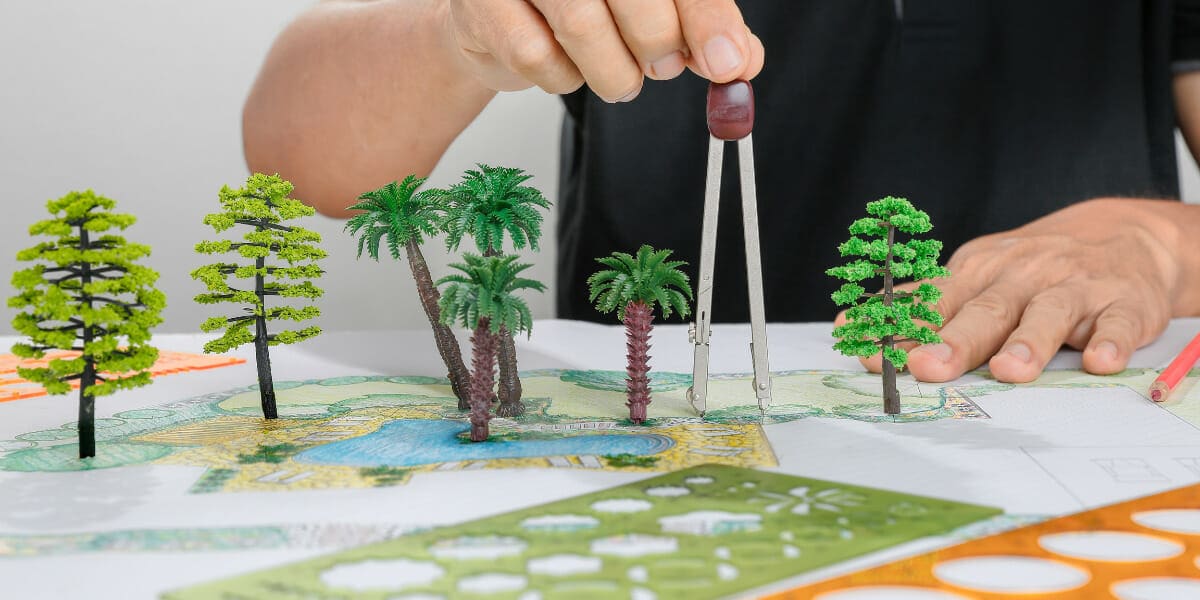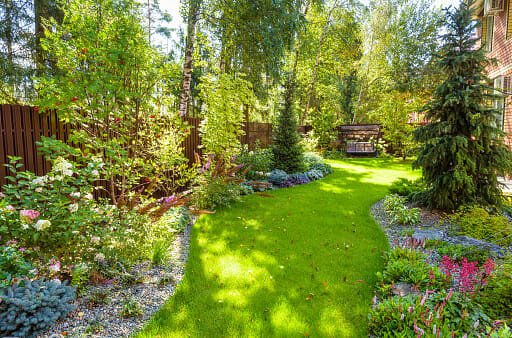Branching Out: The Economic Benefits of Landscape Architecture in Property Development
Landscape architecture plays a pivotal role in enhancing the intrinsic and monetary value of properties. As the urban landscape evolves and environmental concerns grow, the significance of well-designed outdoor spaces cannot be overstated. This article delves into the multifaceted impact of landscape architecture on property worth, highlighting the symbiotic relationship between aesthetically pleasing outdoor environments and real estate value.
Firstly, a thoughtfully crafted landscape not only beautifies a property but also provides functional benefits such as improved usability, privacy, and outdoor living spaces. Beyond aesthetics, it contributes to the ecological well-being by promoting biodiversity, mitigating urban heat islands, and managing stormwater runoff, all of which can appeal to environmentally-conscious buyers.
Moreover, the curb appeal of a well-landscaped property is undeniable. A stunning garden or an inviting outdoor area can make a powerful first impression, attracting potential buyers and boosting the perceived value of a home. As we explore the dynamic interplay between landscape architecture and property worth, we’ll examine these aspects in greater detail, shedding light on the art and science behind this transformative discipline.
Curb Appeal: The First Impression
The impact of first impressions on property value:
First impressions are pivotal when it comes to the value of a property. Curb appeal, or the immediate visual appeal of a home from the street, can significantly affect a property’s value. Homes with strong curb appeal tend to command higher prices in the real estate market. When potential buyers or appraisers assess a property, their initial perception sets the tone for the entire evaluation process. A well-maintained exterior not only increases the perceived value of a home but can also justify a higher asking price.
How landscape design contributes to curb appeal:
Landscape design plays a fundamental role in enhancing curb appeal. A thoughtfully designed front yard can transform a property, making it more inviting and aesthetically pleasing. Elements like lush green lawns, well-manicured shrubs, colorful flower beds, and neatly trimmed trees can create a harmonious and attractive environment. Additionally, the choice of hardscape features such as pathways, driveways, and exterior lighting can further enhance the overall appeal of the property. Well-executed landscape design not only beautifies the home but also helps create a strong emotional connection with potential buyers.
Examples of stunning landscape features for curb appeal enhancement:
- Colorful flower beds: Seasonal flowers in vibrant colors can add a pop of color and freshness to the front yard.
- Well-maintained lawns: A lush, green lawn creates a clean and inviting look.
- Symmetrical landscaping: Balanced planting and hardscape features can provide a sense of order and elegance.
- Outdoor lighting: Strategically placed lighting fixtures can highlight architectural details and make the property look inviting at night.
- Ornamental trees: Unique and well-placed trees can add character and shade to the front yard.
- Maintained pathways: Attractive walkways and driveways with quality materials create a polished appearance.
Curb appeal is not just about aesthetics; it’s an investment in the property’s value. Thoughtful landscape design and maintenance are essential elements in creating a positive first impression that can ultimately translate into higher property values and quicker sales in the real estate market.

Functionality and Usability
Functionality and usability are critical aspects of landscaping that not only enhance the aesthetic appeal of outdoor spaces but also contribute to the overall value and sustainability of a property.
- The practicality of well-planned landscapes: Well-thought-out landscaping designs prioritize functionality by creating outdoor spaces that serve a purpose. This includes elements such as strategically placed pathways, proper drainage systems, and efficient irrigation. A functional landscape is easier to maintain, reducing the time and effort required for upkeep. It also enhances safety by minimizing tripping hazards and ensuring proper lighting. Practical landscaping can also improve accessibility, making outdoor spaces more inclusive and accommodating for people with disabilities.
- Outdoor living spaces and their property value contribution: Incorporating outdoor living spaces like patios, decks, and outdoor kitchens not only increases the usable square footage of a property but also significantly boosts its market value. These spaces offer opportunities for relaxation, entertainment, and dining, making them highly desirable to homeowners and potential buyers. Additionally, they blur the lines between indoor and outdoor living, creating a seamless transition and adding to the property’s charm.
- Sustainable landscaping practices and their appeal to potential buyers: Sustainable landscaping practices, such as using native plants, implementing efficient irrigation systems, and reducing water consumption, are not only environmentally responsible but also attractive to eco-conscious buyers. These practices can lower utility costs, reduce maintenance expenses, and enhance a property’s curb appeal. Sustainable landscapes also often require less chemical treatment and foster biodiversity, creating a healthier and more appealing outdoor environment. Buyers increasingly value properties that align with their eco-friendly values, making sustainable landscaping an investment in both functionality and marketability.
Property Zoning and Regulations
- Landscape architecture plays a crucial role in assisting property owners and developers in achieving compliance with local property zoning and regulations. Through thoughtful design and planning, landscape architects can help optimize land use while adhering to zoning requirements. They utilize their expertise to create aesthetically pleasing and functional outdoor spaces that align with zoning ordinances, such as setbacks, lot coverage, and height restrictions. They also incorporate sustainable practices, ensuring compliance with environmental regulations. By integrating green infrastructure, such as rain gardens or permeable pavements, landscape architects help manage stormwater runoff in compliance with municipal codes. Additionally, their designs can enhance privacy, buffer noise, and mitigate visual impacts, addressing concerns raised by zoning laws. Through innovative approaches and creative problem-solving, landscape architects contribute to harmonizing property development with zoning regulations.
- Navigating local zoning laws and regulations can be a complex and daunting task for property owners and developers. Landscape architects are well-equipped to guide them through this process. They possess a deep understanding of local zoning ordinances, land-use regulations, and permitting procedures. By collaborating closely with clients and municipal authorities, landscape architects can ensure that projects align with the specific requirements of the zoning code. They can prepare and submit comprehensive site plans and documentation, reducing the likelihood of delays or regulatory hurdles. Moreover, landscape architects can offer insights into potential variances or waivers that may be available to clients, helping them explore options within the bounds of the law.
- Professional landscape architects play a critical role in ensuring compliance with property zoning and regulations. They act as liaisons between clients and regulatory bodies, helping clients navigate the complexities of zoning codes. Landscape architects bring their technical expertise and creative design skills to develop plans that meet both aesthetic and regulatory standards. They conduct thorough site analyses to identify constraints and opportunities, allowing clients to make informed decisions that align with zoning requirements. Throughout the project, landscape architects oversee the implementation of design elements that comply with zoning laws, such as proper setbacks, green space allocation, and screening. Their commitment to sustainability and environmental stewardship ensures that projects adhere to environmental regulations, contributing to responsible and compliant development. Overall, landscape architects serve as indispensable allies in the pursuit of property development that harmonizes with zoning regulations and enhances the built environment.
Energy Efficiency and Environmental Benefits
- Landscaping plays a pivotal role in energy conservation by strategically shaping the microclimates around buildings. Thoughtful placement of trees, shrubs, and hedges can provide natural shade during hot summers, reducing the need for air conditioning. Similarly, strategically positioned windbreaks can shield buildings from cold winter winds, lowering heating demands. This approach not only minimizes energy consumption but also enhances the comfort of occupants. Moreover, green walls and fences made of vegetation further contribute to temperature moderation and can serve as insulating barriers.
- Green roofs, trees, and native plantings offer numerous environmental benefits. Green roofs, covered in vegetation, reduce heat absorption and provide additional insulation, thereby decreasing indoor temperature fluctuations and energy consumption. Trees, apart from supplying shade, also sequester carbon dioxide, purify the air, and enhance overall urban aesthetics. Native plantings are particularly sustainable as they require less water and maintenance, contributing to a reduction in resource consumption and fostering biodiversity.
- The long-term cost savings and sustainability factors associated with energy-efficient landscaping are substantial. While initial investment may be required for landscaping, the ongoing savings in energy bills and reduced maintenance costs more than offset these expenses over time. Furthermore, environmentally friendly landscaping practices align with sustainability goals by reducing greenhouse gas emissions, conserving water, and promoting biodiversity. Ultimately, integrating energy-efficient landscaping into urban planning and building design not only leads to financial benefits but also supports a healthier, more environmentally responsible future.
Property Resale Value
The Direct Impact of Landscaping on Resale Value:
Landscaping plays a pivotal role in enhancing a property’s resale value. A well-maintained and aesthetically pleasing landscape can significantly increase a home’s appeal to potential buyers. Curb appeal, which is the visual attractiveness of a property from the street, is greatly influenced by landscaping. A neatly manicured lawn, thoughtfully designed flower beds, mature trees, and attractive hardscape features like patios or walkways can make a lasting first impression.
Furthermore, landscaping can improve the functionality and usability of outdoor spaces, making them more appealing to buyers. Features such as outdoor kitchens, fire pits, and seating areas can create additional living spaces and add value to the property.
ROI for Various Landscaping Projects:
The return on investment (ROI) for landscaping projects can vary depending on the scope and quality of the work. Generally, landscaping projects tend to yield a high ROI compared to many other home improvement projects. For example, a well-executed landscaping project can provide an ROI of 100% to 200% or even more, meaning homeowners can recoup their investment and potentially make a profit when selling their property.
To maximize ROI, homeowners should consider factors like the local real estate market, the specific preferences of potential buyers in the area, and the overall condition of their property. Low-maintenance landscaping and sustainable features like drought-tolerant plants or energy-efficient lighting can also boost ROI by reducing ongoing maintenance costs and appealing to eco-conscious buyers.
Case Studies of Properties with Increased Resale Value Due to Landscaping:
Numerous case studies highlight the positive impact of landscaping on resale value. For instance, a study by the National Association of Realtors found that well-landscaped homes can sell for 7% more than homes with minimal landscaping. Another case in point is a property in a suburban neighborhood where a professional landscaping overhaul resulted in a 15% increase in resale value within a year.
Additionally, urban properties with rooftop gardens or well-designed outdoor spaces have seen substantial appreciation in value. These case studies underscore the notion that strategic landscaping investments can yield substantial returns when selling a property, making it a wise choice for homeowners looking to maximize their resale value.
Maintenance Considerations
- The Importance of Ongoing Maintenance: Effective maintenance is the lifeblood of any landscape. It not only ensures the aesthetics but also sustains the functionality and health of your outdoor space. Regular upkeep helps prevent small issues from becoming costly problems. For instance, trimming overgrown branches can prevent potential hazards, such as falling limbs, while routine weeding and mulching promote plant health. Neglecting maintenance can lead to deteriorating curb appeal, which can adversely affect your property’s overall value. Moreover, a well-maintained landscape enhances the quality of life for residents, providing a peaceful and enjoyable environment.
- Budgeting for Landscape Upkeep: Budgeting for maintenance is a crucial aspect of property ownership. Allocate funds for tasks like mowing, pruning, fertilizing, and pest control, as well as for occasional larger projects such as tree removal or irrigation system repairs. An adequately funded maintenance budget ensures that your landscape retains its beauty and functionality over time while preventing the need for emergency expenditures due to neglect. Regular monitoring of expenses allows for adjustments and cost-effective strategies.
- Low-Maintenance Landscaping Options for Property Value Retention: For those concerned about both aesthetics and long-term affordability, low-maintenance landscaping options can be a wise choice. Utilizing native plants, xeriscaping, or hardscaping features like gravel paths and rock gardens can significantly reduce upkeep requirements. These options not only save time and money but also contribute to property value retention by offering a well-maintained appearance with minimal effort. Planning for drought-resistant plants and efficient irrigation systems can further reduce water usage and maintenance costs, adding to the sustainability and value of your property.

Choosing a Landscape Architect
When choosing a professional landscape architect, several key qualities should be considered. First and foremost, expertise and qualifications are crucial. Look for architects who hold relevant degrees, certifications, and licenses in landscape architecture. Experience matters too, as seasoned professionals often bring a wealth of knowledge and a portfolio of successful projects.
Furthermore, creativity and a strong design aesthetic are essential traits. A talented landscape architect can transform outdoor spaces into visually appealing and functional environments. Good communication skills are also vital for understanding your needs and translating them into a cohesive design.
Hiring a licensed and experienced landscape architect offers numerous benefits. Licensed professionals have undergone rigorous training and adhere to industry standards and ethical guidelines. They possess a deep understanding of local regulations and environmental considerations, ensuring your project complies with legal requirements.
Experience plays a pivotal role in problem-solving and delivering innovative solutions. Seasoned architects have likely encountered various challenges in their career and can navigate them effectively. Their expertise can also save you time and money by preventing costly mistakes during the design and construction phases.
Collaborating effectively with a landscape architect involves clear communication and a shared vision. Begin by defining your goals, preferences, and budget. Encourage open dialogue and provide feedback throughout the design process. Trust their expertise while offering constructive input to achieve a balanced outcome.
Regular meetings and updates help maintain transparency and alignment. Additionally, be prepared to compromise when necessary, as successful collaboration often involves finding middle ground between your desires and practical considerations. A collaborative approach ensures that the final landscape design not only meets your expectations but also thrives in its intended environment.
Conclusion
In conclusion, the enduring influence of landscape architecture on property value cannot be overstated. As explored in this discussion, the careful planning and execution of landscaping projects can significantly enhance a property’s worth. Beyond the immediate visual appeal, well-designed landscapes contribute to environmental sustainability, curb appeal, and overall quality of life. They create an inviting atmosphere that not only pleases homeowners but also attracts potential buyers, leading to increased demand and subsequently higher property prices. This phenomenon underscores the dual benefits of investing in landscaping—personal enjoyment and financial gain.
For homeowners, this should serve as a compelling encouragement to consider landscaping not merely as an aesthetic pursuit but as a savvy investment. By nurturing their outdoor spaces, homeowners not only create beautiful environments for themselves but also potentially bolster their long-term financial security. In essence, landscape architecture exemplifies the convergence of art and economics, offering an enduring testament to the value of thoughtful design and stewardship of the natural world.



